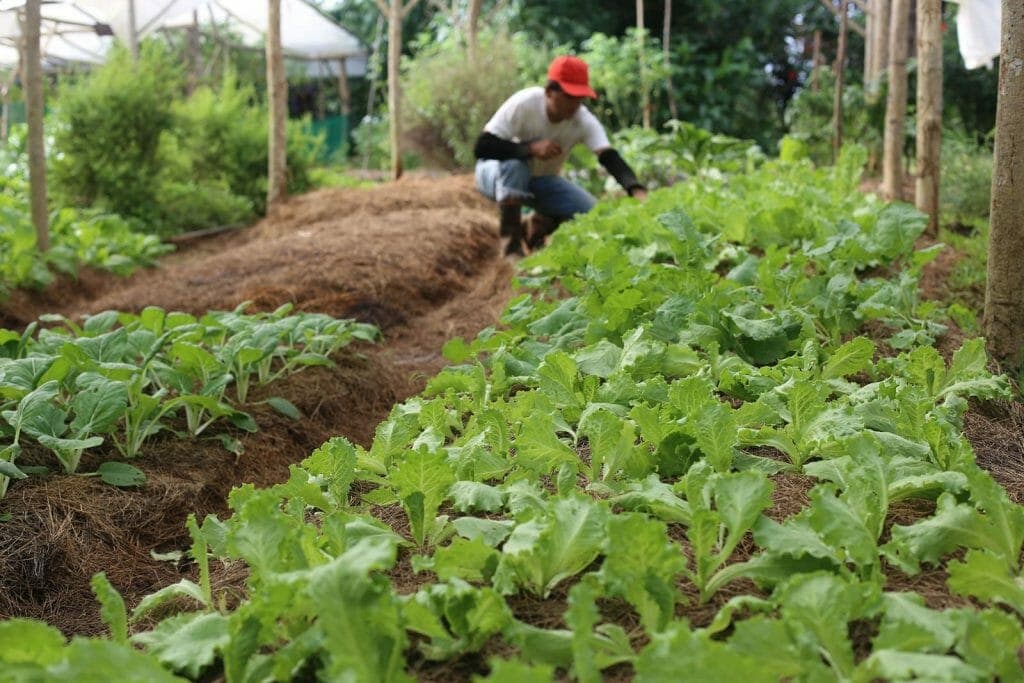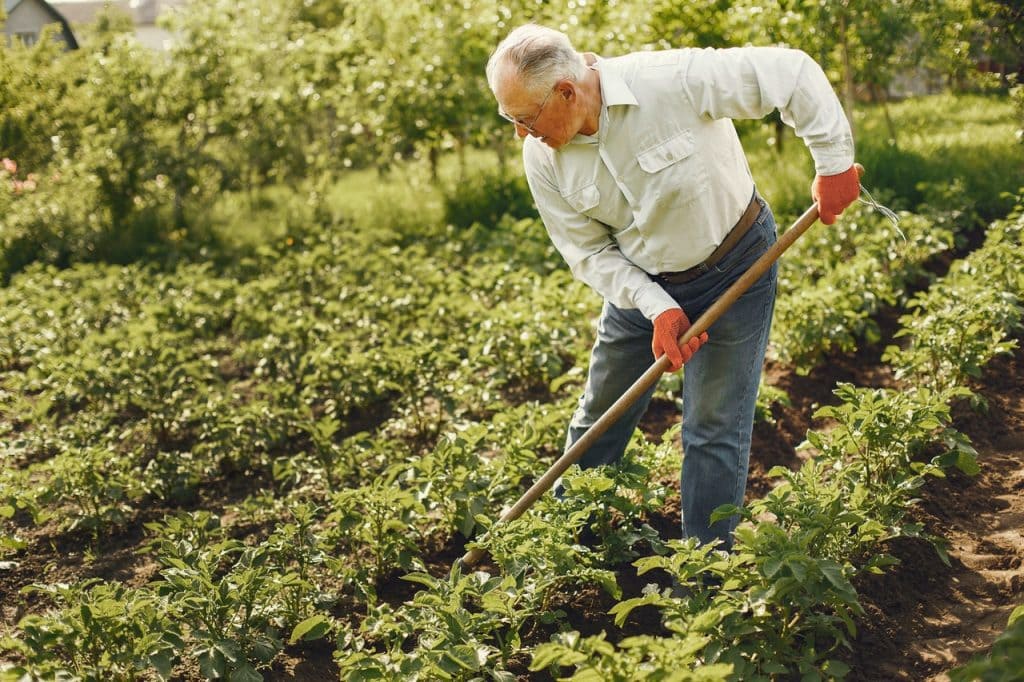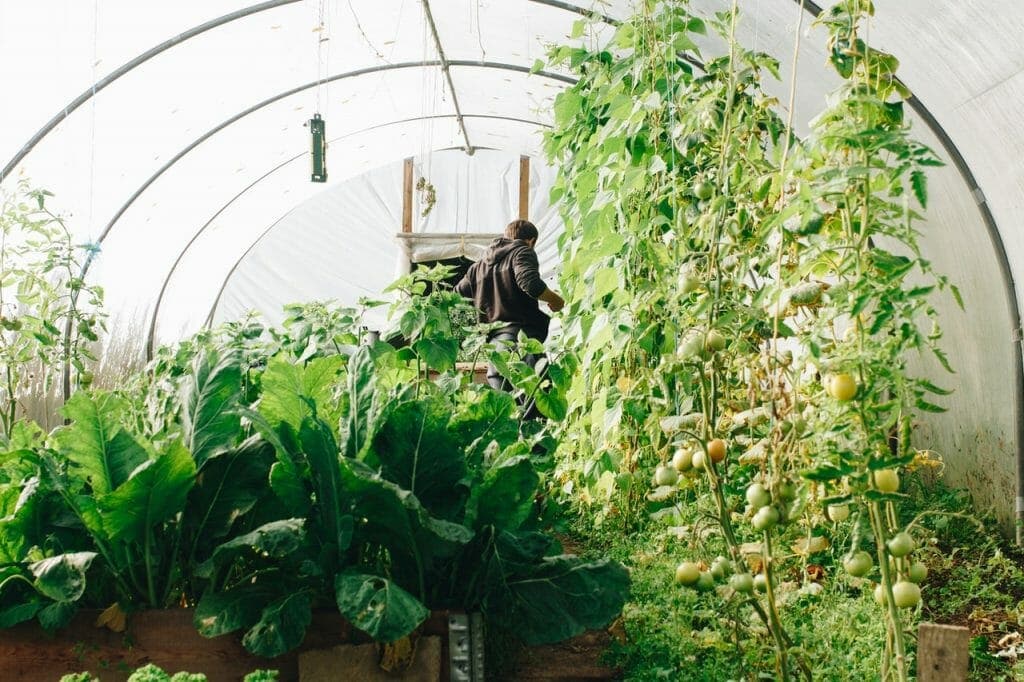Written by Christy Wilhelmi and published on https://www.motherearthgardener.com/.
Biointensive gardening focuses a lot on the quality of the soil. When farmers use biointensive gardening, they will loosen up the soil at least twice as deep as normal gardening preparations. This way, their plants’ roots can penetrate through the soil deeper and get more nutrients and water from deep underground. Biointensive agriculture is an organic agricultural system that focuses on achieving maximum yields from a minimum area of land, while simultaneously increasing biodiversity and sustaining the fertility of the soil. The goal of the method is long term sustainability on a closed system basis.
Additionally, how do you grow vegetables in 9th edition? How to Grow More Vegetables, Ninth Edition: (and Fruits, Nuts, Berries, Grains, and Other Crops) Than You Ever Thought Possible on Less Land with Less Water Than You Can Imagine Revised ed. Edition. Find all the books, read about the author, and more.
The Biointensive Garden: Getting the Most Out of a Small Garden
We need more land. That’s typically whata gardener thinksafter his or her first season of successful gardening. While it’s prudent to start small, it’s only a matter of time before we yearn for more space to grow. There are so many new and newly discovered seeds to try (so it seems) and never enough space for all of them.
We dream of having the luxury of acres to work with, but the truth is that most home gardeners are limited to a few hundred square feet for growing food crops. In most urban settings, that number decreases to under 100, so it’s important to utilize the space we have to achieve the highest yields without compromising sustainability. Enter biointensive gardening.
“Biointensive” is an umbrella term used to describe several methods for growing a lot of food in a small space. The idea centers around nutrient-rich soil that can support growing crops closer together, reducing the amount of resources and hands-on labor required. It incorporates compost, livestock, beneficial insectaries, and strives toward a closed-loop system on a homestead, whatever the size. Sound intriguing? Let’s take a closer look.
Over the years biointensive gardening has taken many forms. To understand these concepts, we first have to take a step back in history. Biointensive methods were used by ancient Romans and have traveled alongside us through the years, morphing with other techniques and integrating modern innovations. In essence, this is the way our ancestors farmed before industrial farming changed everything.
It starts with creating your ecosystem, that is, not just what’s in your garden beds, but everything around it. A healthy garden is surrounded by habitat for beneficial insects, so good bugs can take care of bad bugs for you. It may include habitat for bats or toads (which also eat bugs) and it may even provide food for wildlife (deterrents away from our highly protected vegetable beds). A healthy ecosystem has a way of recycling nutrients, be it by composting or mulching beneath existing perennials. As mentioned before, these concepts may have sprung to life long ago, but they came into focus with Rudolf Steiner.
Biodynamics
Steiner was an Austrian scientist and philosopher who developed the concept of Biodynamics in Europe in the 1920s. His work found its way to the United States in the 1930s, encouraging farmers to view their entire farm as a living organism. His guidance led people to develop self-sustaining systems, integrating livestock manure as fertilizer and growing feed for the livestock on site. Pest problems were viewed as a symptom of a weakened system, and measures were taken to bolster the system (think soil microbiology here) to heal the organism.
Going beyond what we typically consider to be the boundaries of our ecosystem, Steiner studied the lunar calendar and determined that certain activities such as seeding, harvesting and even weeding were more effective if done during specific times in the moon’s cycle. Sound like hooey? Even today, there are scientific studies showing higher yields and nutrient content in vegetables grown Biodynamically.
Biodynamics also uses preparations (numbered 500-508), combinations of herbs such as valerian, stinging nettles, chamomile and yarrow which have been fermented and are then used to inoculate compost or sprayed as a tea on soils. Think of it the same way you would when making yogurt. You have a starter culture that inoculates warmed milk, and that culture multiplies and spreads throughout the medium. Soil microbiology works similarly, and the more viable the microbes, the healthier your soil will be. So how does this all work on a small scale? We’ll get to that shortly, but first, French Intensive.
French Intensive
As the name implies, 20th century French farmers developed this method in order to grow their livelihood outside the city of Paris. It involves conditioning the soil to a depth of 24 inches. Most of us know that by its modern name: Double Digging. Those who have done it will attest that it can be back-breaking work. The top 12 inches of soil in a garden bed is removed. Compost is added and worked into the lower 12 inches of soil, then the top soil is replaced, creating a mounded raised bed. What this accomplishes is a loamy, loose soil structure, rich with organic matter that is easier for roots to penetrate. Deeper root systems mean larger plants and higher yields.
French Intensive method also utilizes small spaces by planting in hexagonal (or offset) rows. Gone are the wide pathways between rows. Typical beds are 4 to 5 feet wide and as long as 100 feet. Crops are nestled up against one another, forming living mulch as they grow. As their shoulders touch, the plants block the sun from reaching the soil. That means fewer weeds and less evaporation of water from the soil, both time- and resource-saving techniques. Like Biodynamics, French Intensive utilizes animal manures. In the early days, the waste from the transportation department (horses) was recycled by giving it to the farmers. The farmers carried manure in tall, wooden backpacks into their fields to build up soil and form mounded raised beds.
Another signature symbol of French Intensive gardening is the bell jar, which served as a cloche to protect plants in the field. Row upon row of hexagonally placed bell jars would shelter seedlings as they grew. We home gardeners mimic that today with plastic bottles or wall-o-water contraptions, whereas farmers use poly tunnels.
French Intensive gardeners were famous for their ability to achieve high yields all season long. Raised beds were never left fallow, but were instead planted with heavy feeders (tomatoes and corn) followed by heavy givers (legume and cover crops), followed by light feeders (lettuces). By constantly feeding the soil, farmers were able to continually cultivate. We can integrate these ideas into our gardens to increase our own yields.
Alan Chadwick
Along came Alan Chadwick, an Englishman who studied with Rudolf Steiner and decided to combine Biodynamic and French Intensive concepts for something even more integrated. He borrowed “farm as living organism” and “integration of livestock” and the lunar calendar from Biodynamics, and took double digging and hexagonal planting from French Intensive to develop something cohesive. His work at the University of California Santa Cruz in Northern California raised the technique to an art form some 40 years later. Shortly thereafter, John Jeavons of Ecology Action in Willits, Calif., took Chadwick’s work even further.
Grow BioIntensive — Mini-farming
John Jeavons also approached the idea of farming from a soil perspective, but his research showed that due to our planet’s industrial agricultural practices and desertification, we were losing farmable land globally. Soon we will need to be able to produce everything we need on much less land. Taking Chadwick’s work to heart, Jeavons calculated a formula in his book, How to Grow More Vegetables … and that formula is 60/30/10.
To be completely sustainable, we have to produce organic matter on site. Conventional agriculture loses about 24 pounds of top soil for every pound of food we eat that is grown that way. Organic agriculture is better, but still not completely sustainable. Only about 8 pounds of top soil are lost for every pound of organic food we consume. With Jeavons’s method, we can actually generate around 22 pounds of top soil for our gardens. How? Here’s where the formula comes in.
If we can dedicate 60 percent of our land to growing “compost and carbon crops” we will have enough biomass to make enough compost to never have to buy bagged compost from a nursery again. While 60 percent sounds like a lot of space, it’s a goal that might be easier to achieve than you think. Compost and carbon crops include grains like wheat, rye, corn, oats, millet and quinoa, as well as legumes like fava beans. Many of us already grow these as cover crops over winter. These crops generate biomass that feeds your compost bin, creating more compost for garden use next spring. Now that’s a closed-loop system.
Let’s move on to 30 percent. These crops are high-calorie crops. While it’s true that in first-world countries we are more often trying to reduce our calorie intake, in less fortunate countries where food is scarce and resources are virtually non-existent, having enough to eat is a big deal. It becomes critical to produce as many calories as possible in the smallest amount of space. Crops like potatoes, sweet potatoes and parsnips produce a lot of calories for the amount of space they take up in a garden plot. If the zombie apocalypse strikes, these crops will sustain us longer than salad greens.
The final number in our formula, 10 percent, is for everything else we love to grow. Tomatoes, peppers, lettuces, broccoli, etc. all fit into this category. Remember, this is a goal toward true sustainability, so even if these numbers don’t seem attainable right now, the important thing is to try to incorporate a few of these techniques into your home garden ecosystem to improve the health and vitality of your soil.
Square Foot Gardening
There’s one more biointensive method to explore, one that is quite possibly the most popular technique of modern home gardening. Mel Bartholomew, an engineer with a notion that there has to be a better way to garden, developed Square Foot Gardening back in the 1970s through his PBS series and a book of the same name. He threw conventional farm rows aside and carved out space in 4 x 4-square-foot beds instead. His technique works in such a way that once you have your garden beds set up, you never need a shovel again. Each square foot is planting and tended individually. So if, for example, one square foot has radishes growing and the next square foot has lettuces, the radishes will be harvested first as the lettuces continue to grow.
Mel attests that all you need to do is throw in a handful of compost into that now-empty square foot and you’re ready to plant another crop. Beds are divided physically into square feet and each square foot is divided depending on what is being planted. Large crops like broccoli and kale are planted in the center of each square foot while lettuces are planted in a four-square pattern, one in the center of each divided quadrant (4 per square foot). Bush beans are planted in a tic-tac-toe pattern and root crops can fit 16 per square foot. It’s very efficient in other ways, like vertical gardening. We’ve all heard of growing pole beans and cucumbers up a trellis to save space, but Mel suggests melons and squash can do the same with support.
Square Foot Gardening can be adapted for patios, elevated on legs for disabled or elderly folks, and manipulated to any size or shape for small spaces or small gardeners (kids). While Mel does use bagged compost to fill the raised beds, you can incorporate your homemade compost into the mix to be more self-reliant.
Each of these biointensive methods inspires further investigation and there are plenty of books on the subject to keep you reading all season long. However you choose to tackle the biointensive concept, know that any step you take is one toward a truly sustainable ecosystem for many seasons to come.
Original post here https://www.motherearthgardener.com/organic-gardening/techniques/biointensive-gardening-zmaz14uzsbak.



